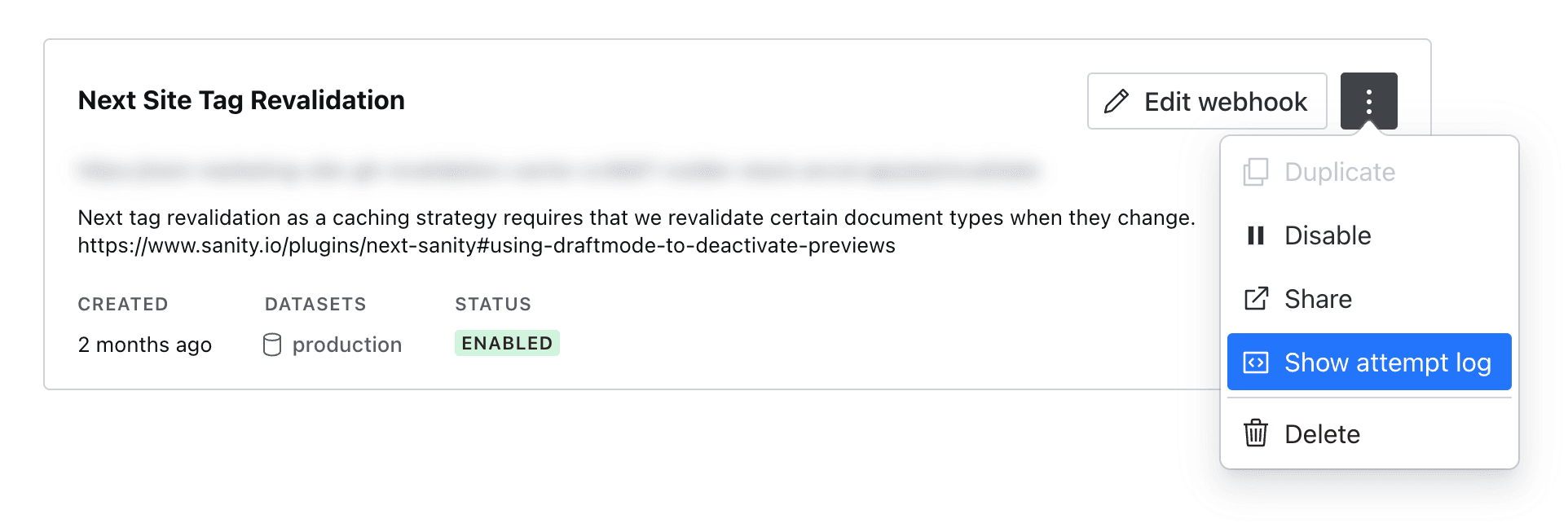Implementing Tag Revalidation Caching using NextJS and Sanity

At the time I joined RudderStack, the marketing site was built on Gatsby. One of our main internal customers is the marketing team, with a considerable number of users creating, editing, and publishing varying types of content to the site. Now, a year and a half later, our current major priority is migrating rudderstack.com to Next.js. At this point, a large portion of the site has been incrementally migrated, unlocking potential cutting-edge features. One such feature we recently implemented is the new tag revalidation (or on-demand) caching strategy from Next.js. This new feature decreased our site build times, decreased requests to Sanity, our CMS, simplified our content editors' workflow, and significantly sped up release times. Cost ⬇️ + Efficiency ⬆️ = Business 📈
In this guide, I’ll provide the details of our implementation with a nitty gritty how-to. First, I’ll give a short overview of the project and the impact it’s had on our build times and workflow. Here’s a look at our web stack for context before we get started:
- Content Management System: Sanity
- Deployment and Hosting: Vercel
- Frameworks: Gatsby & Next.js
- Notable Dependencies: TypeScript, Material UI, Turborepo
Overview
Many websites use static site generators to create a fully-static HTML website from raw data and a set of templates. This method automates the coding of individual HTML pages and prepares them to be served to users before they are requested. There are several benefits to server-side rendering, namely speed and caching.
Other applications require more dynamic data (like the information only available to a logged-in user). In these cases, applications may generate pages at request time or push code to users' browsers that offloads the fetching of data and building of HTML. There are a few benefits to client-side rendering.
Next.js is a React framework for building full-stack web applications, offering both server-side and client-side rendering. For a marketing website like ours, rudderstack.com, we want as render as many pages on the server as possible. Next.js allows us to generate those pages during the build process.
The Next.js build process occurs frequently at RudderStack – whenever the development team pushes code to a branch in our GitHub repository, when website content editors from business teams manually trigger a deployment via the Sanity Studio, or when we deploy from the Vercel CLI. This process takes about 4-8 minutes to complete, delaying our content editors from immediately releasing changes to production. To enable a more efficient workflow, we wanted to drastically reduce these build times.
Production Releases: Before & After
Before we changed our caching strategy, our implementation of Next and Sanity required a deploy every time we wanted to release a content change to production because we wanted the speed of statically generated pages on the server. The flow was as follows:
- Make content edits – Sanity utilizes a "published" state to determine which content is production-ready
- Trigger Deploy – custom Sanity dashboard buttons allow our content team to trigger Vercel deploys
- Build Process – a 5-10 minute build process begins where data is fetched from Sanity and used to build out statically generated pages
- Production Release – at the end of a successful build, the deployment process automatically releases the build to production at rudderstack.com
This flow worked well, but releases could take longer than desired and would be delayed if there happened to be an error in the build process. With the tag revalidation caching strategy, our new flow follows this pattern:
- Make content edits – Sanity utilizes a "published" state to determine which content is production-ready. This now triggers a webhook that hits an endpoint on the Next app with the type of data that was changed (tag).
- Tag Revalidation – the endpoint on the frontend fires off the new revalidateTag() function, causing the server to refetch any queries that are dependent on the tag that was received from the Sanity webhook.
- Server Re-render – any pages that were dependent on that newly fetched (revalidated) data are re-rendered on the server and served up on the next request.
This new flow significantly decreased both our total build times and total fetches to Sanity, saving us money. Perhaps more importantly, it simplified our content editor's workflow and sped up our release times, increasing our efficiency.
Implementation: On-demand revalidation with Next.js
The Next.js cache tagging system for invalidating fetch requests across routes is called "tag revalidation" or "on-demand revalidation". We implemented this cache tagging system by utilizing the Next.js revalidateTag() function and Sanity's next-sanity library (a wrapper around @sanity/client that is fully compatible with Next's caching features). Within the Next/Vercel ecosystem, revalidateTag() allows you to purge cached data on-demand for a specific cache tag.
Utilizing this functionality gave us nearly-instantaneous deploy-less content updates.
Critical Dependencies
Please note that that a critical change for this functionality landed in next v14.0.4
- next @ 14.0.4 (App Router)
- next-sanity @ 7.0.3
- sanity @ 3.20.2
Server-side Rendering
If you're coming from the world of single-page applications (SPAs), you may be familiar with the concept of loading client-side Javascript that fetches data and utilizes libraries like React or Vue to render and display that content. And if you've been a developer for any amount of time, you know that nothing stays new for very long. In fact, you may have realized that the web works in cycles and we’re all in the process of getting back to our roots. In the past, everything was rendered on the server. Then, up until recently, we were rendering entirely too much on the client. Now, we’re attempting to tackle the best of both worlds: the speed of the server and the dynamic nature of the client. Enter React Server Components, or RSCs, which individually fetch data and render HTML entirely on the server, eliminating the need for client-side re-rendering, thereby improving performance.
React Server Components
One of the reasons we love Next is due to their opinionated, prolific use of RSCs. If you spin up a brand new Next app and include TypeScript, you'll get some wonderful tooling that helps alleviate some of the confusion around when, where, and how to implement RSCs. If you're unfamiliar with the flow and benefits of RSCs, Next has some great documentation on rendering environments and Vercel's blog post, "Understanding React Server Components" is a must-read. Josh W. Comeau has a great primer on RSCs, as well.
Front-end Implementation
Instrumenting
Before the introduction of the tag revalidation caching strategy, next-sanity utilized @sanity/client to provide a fetching function that we wrapped in React.cache().
TSX
This gave us optimized and cached fetches but only within the React context, meaning that if an exact duplicate request was made, React would prevent the fetch to Sanity and utilize locally cached data. A welcome optimization, for sure, but unhelpful when the data has changed since the initial request response was cached.
With the advent of tags, we were able to remove React.cache() from the client.tsx and import it into a new clientFetch() function that passes tags through as options in the fetch request. Other fetch options are available but be aware that they may cause conflicts when used in tandem.
TSX
This new function also receives a return type (QueryResponse) that keeps our async functions clean and tidy. You'll also notice some references to isDraftMode above. Next.js provides the ability to switch to dynamic rendering (rendered at request time instead of build time) via next/headers:draftMode(), allowing us to fetch draft content instead of published content. We enable/disable draftMode via Next Route Handlers. Sanity has Next.js-specific documentation if you are interested in that functionality.
Fetching
Now that our new tag-revalidated fetching functionality is available, we can pass an array of tags through with each request, allowing Next.js to associate multiple requests with particular tags. Under the hood, Next.js extends the native fetch Web API to allow you to configure the caching and revalidating behavior (tags) for each fetch request on the server. These tags can be an array of simple strings but in our case – using Sanity – tags are synonymous with document types (represented within the Sanity schema as _type). This will make more sense in the API Route Handler and Sanity Webhook sections below.
Sanity utilizes a custom query language called GROQ which is very powerful but has a bit of a learning curve. To fetch the necessary data to render rudderstack.com/learn, our groq query is as follows:
TSX
Without worrying too much about the syntax or the mixing of snake- and camel-case, you can see that two types of documents are being fetched: learning_center and learningCenterCategories.
When we use this query, we ensure that those document types are passed as tags:
TSX
Now, whenever the learning_center or learningCenterCategories tag is revalidated, Next.js will clear the cached data, refetch the query above from Sanity, and cache that newly-fetched data — all on the server and all without requiring a new build.
API Route Handler
So, how do we revalidate those tags we passed to clientFetch() for fetching the data to render /learn? In order to fire off revalidateTag, we need to set up an API route in our Next.js app that handles an incoming request, in this case, made by a GROQ-Powered Webhook.
TSX
First, we use next-sanity/webhook:parseBody() to validate that the request came from an approved source. This is done by passing in process.env.SANITY_REVALIDATE_SECRET, a string generated by Sanity's webhook interface. We’ll get there shortly.
If the request includes a _type, we pass it into revalidateTag() (remember, these represent document types within Sanity and tags within the frontend).
Upon successful revalidation, we return a 200 with a revalidated boolean, a timestamp, and the body of the request. Sanity logs these attempts and responses in their webhooks interface.
At this point, you'll need to deploy your next app to Vercel in order to expose your API endpoint publicly. It won't work until you create your Sanity webhook, generate a Secret, and add it to the Environmental Variables in your Vercel project and copy the deployment URL.
Sanity Webhook
Head over to Sanity's project management tool (not the Studio) to create the webhook that will ping the revalidate endpoint when any document is published. The URL for your Sanity project management tool should follow this format, where the organizationId and projectId are specific to your account:
https://www.sanity.io/organizations/[organizationId]/project/[projectId]
Once you're in, click the API tab and the button to create a new webhook. Paste the deployment URL you copied from the API Route Handler step above, appending /api/revalidate to the end. Set the following values:
- Dataset – development, assuming you have a dataset that can be tested against
- Trigger On – check all 3: create, update, and delete
- Filter – leave this blank unless there are only particular types of documents that you want to revalidate
- Projection – add "{ _type }"
- Status – check this and enable the webhook
- HTTP Method – POST
- HTTP Headers – leave blank
- API Version – the latest here should be fine but ensure that it aligns with what you have set in your Sanity project
- Drafts – leave unchecked
At the bottom of the list, generate a Secret and copy the value. Save your new webhook and return to the webhook listing page. To the right of your newly-created webhook, you'll see 2 buttons, one to expose more options. Click it and select "Show attempt log", opening a new tab with the attempt log.
 Sanity's Webhook Options
Sanity's Webhook OptionsHead back to Vercel and open your Next project. Click the "Settings" tab, then "Environmental Variables" on the left sidebar. Create a new ENV VAR called SANITY_REVALIDATE_SECRET and paste in your Secret generated by the Sanity webhook interface.
Testing
At this point, you should be able to publish a document change in Sanity, and, after a few moments, see that the deployment URL that corresponds to that change (in our example above, we would append /learn to the end of our deployment URL). Voila! Deploy-less content updates!
If you're having issues, check the attempts log you opened earlier. You can also open up the logs for your Vercel project and expand the "Functions" filter in the sidebar, selecting your new api/revalidate endpoint and using the error messages there to help you track down issues.
Once you're ready to go to production, be sure to change your webhook Dataset to production.
Published:
December 15, 2023

Event streaming: What it is, how it works, and why you should use it
Event streaming allows businesses to efficiently collect and process large amounts of data in real time. It is a technique that captures and processes data as it is generated, enabling businesses to analyze data in real time

How Masterworks built a donor intelligence engine with RudderStack
Understanding donor behavior is critical to effective nonprofit fundraising. As digital channels transform how people give, organizations face the challenge of connecting online versus offline giving.

How long does it take you to see a customer event? If it's over five seconds, you're missing out
Access to real-time customer data is no longer a luxury. This article explains how a modern, modern, real-time infrastructure can help you close the gap between customer intent and action—before it’s too late.






